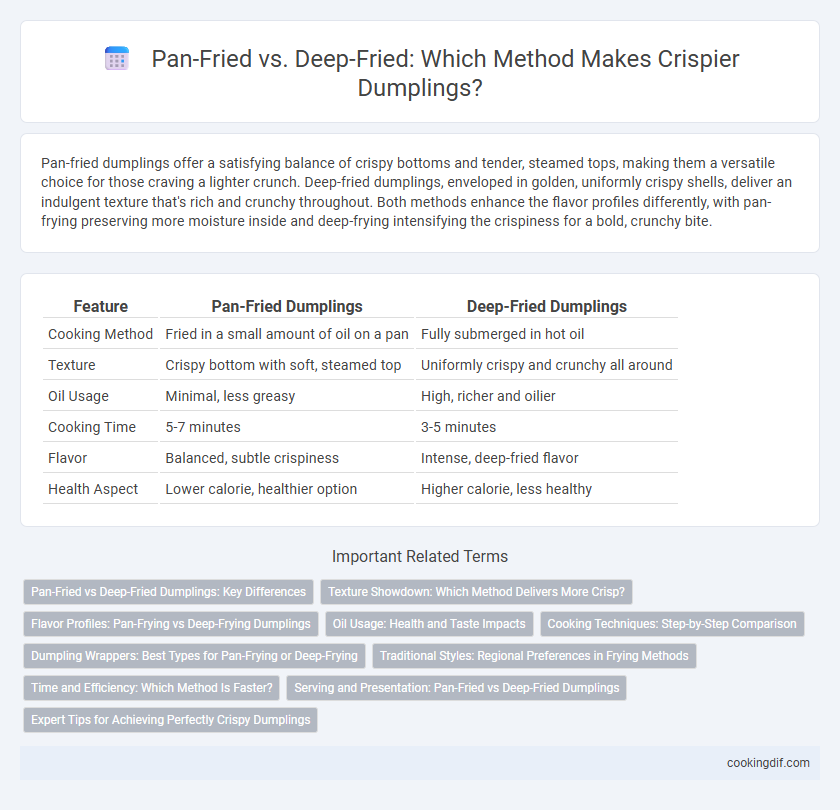Pan-fried dumplings offer a satisfying balance of crispy bottoms and tender, steamed tops, making them a versatile choice for those craving a lighter crunch. Deep-fried dumplings, enveloped in golden, uniformly crispy shells, deliver an indulgent texture that's rich and crunchy throughout. Both methods enhance the flavor profiles differently, with pan-frying preserving more moisture inside and deep-frying intensifying the crispiness for a bold, crunchy bite.
Table of Comparison
| Feature | Pan-Fried Dumplings | Deep-Fried Dumplings |
|---|---|---|
| Cooking Method | Fried in a small amount of oil on a pan | Fully submerged in hot oil |
| Texture | Crispy bottom with soft, steamed top | Uniformly crispy and crunchy all around |
| Oil Usage | Minimal, less greasy | High, richer and oilier |
| Cooking Time | 5-7 minutes | 3-5 minutes |
| Flavor | Balanced, subtle crispiness | Intense, deep-fried flavor |
| Health Aspect | Lower calorie, healthier option | Higher calorie, less healthy |
Pan-Fried vs Deep-Fried Dumplings: Key Differences
Pan-fried dumplings offer a crispy bottom with a tender, steamed top, achieved by frying first then adding water to steam, creating a balance of textures. Deep-fried dumplings are uniformly crispy and golden brown due to being fully submerged in hot oil, resulting in a richer, crunchier exterior. Pan-frying uses less oil and preserves the dumpling's juicy filling, while deep-frying intensifies the crunch but can be greasier and less delicate inside.
Texture Showdown: Which Method Delivers More Crisp?
Pan-fried dumplings achieve a balanced crispness with a golden, crunchy bottom and tender, steamed top, offering a satisfying contrast in texture. Deep-fried dumplings provide an all-over crispiness with a uniformly crunchy exterior, often resulting in a richer, more indulgent bite. For those seeking a combination of crisp and soft textures, pan-frying excels, while deep-frying delivers maximum crunch throughout.
Flavor Profiles: Pan-Frying vs Deep-Frying Dumplings
Pan-fried dumplings offer a balanced flavor profile with a crispy, golden-bottomed crust combined with a tender, steamed interior that enhances the natural taste of the filling. Deep-fried dumplings deliver a uniformly crunchy exterior with a richer, oilier flavor that intensifies the savory notes of the ingredients. Choosing between pan-frying and deep-frying influences texture and taste, with pan-frying emphasizing contrast and deep-frying providing a bold, indulgent crispiness.
Oil Usage: Health and Taste Impacts
Pan-fried dumplings use less oil compared to deep-fried ones, resulting in fewer calories and a lighter texture while still achieving a crispy bottom. Deep-fried dumplings absorb more oil, enhancing the crunchiness and richness but increasing fat content and calorie count. Choosing pan-frying promotes a healthier option with a balanced crispy taste, whereas deep-frying intensifies flavor at the expense of higher oil consumption.
Cooking Techniques: Step-by-Step Comparison
Pan-fried dumplings begin with heating oil in a non-stick skillet, placing dumplings flat-side down, and frying until the bottoms turn golden brown and crisp; then, water is added to steam them, ensuring a tender top and crispy base. Deep-fried dumplings are fully submerged in hot oil at 350degF (175degC) for 2-4 minutes until evenly golden and crunchy all around, producing a consistently crisp texture without steaming. The pan-fry method balances crispiness with softness using both frying and steaming, while deep-frying delivers a uniformly crisp and richer flavor with higher oil absorption.
Dumpling Wrappers: Best Types for Pan-Frying or Deep-Frying
Wheat-based dumpling wrappers with higher gluten content are optimal for pan-frying, creating a chewy texture with a crispy bottom. For deep-frying, thinner wrappers made from rice or tapioca flour yield an ultra-crispy exterior without becoming greasy. Selecting the right wrapper enhances textural contrast, ensuring either pan-fried or deep-fried dumplings achieve maximum crunchiness.
Traditional Styles: Regional Preferences in Frying Methods
Traditional styles of dumplings showcase distinct regional preferences in frying methods, with pan-fried dumplings popular in Northern China for their golden, slightly crispy bottoms and tender tops, while deep-fried dumplings dominate Southern China, prized for their uniformly crisp and crunchy exterior. The pan-frying technique involves searing dumplings in a small amount of oil followed by steaming, creating a balance of textures, whereas deep-frying submerges dumplings in hot oil, producing a richer, crisp texture. These regional frying preferences reflect local culinary traditions and ingredient availability, highlighting the cultural significance of texture in dumpling preparation.
Time and Efficiency: Which Method Is Faster?
Pan-frying dumplings typically takes about 10 minutes, involving an initial sear followed by steaming in the same pan, which ensures a crispy bottom with tender interiors. Deep-frying, however, requires only 3-5 minutes for a fully crispy dumpling, delivering a uniformly crunchy texture but consuming more oil and requiring longer cleanup. For time efficiency, deep-frying is faster, but pan-frying offers a balanced approach by combining crispiness and moisture retention without excessive oil use.
Serving and Presentation: Pan-Fried vs Deep-Fried Dumplings
Pan-fried dumplings feature a golden, crispy bottom with a tender, steamed top, offering a visually appealing contrast that enhances serving presentation. Deep-fried dumplings showcase an even, crunchy exterior all around, providing a uniform crispiness that pairs well with dipping sauces on the side. Presentation-wise, pan-fried dumplings are often arranged upright or slightly tilted to showcase their texture variety, while deep-fried dumplings are commonly served stacked or in baskets to highlight their rich, golden color.
Expert Tips for Achieving Perfectly Crispy Dumplings
Achieving perfectly crispy dumplings requires precise temperature control; pan-frying at medium heat allows the bottoms to develop a golden crust without burning, while adding water and covering the pan steams the filling for a tender interior. Deep-frying demands oil heated to 350-375degF (175-190degC) to ensure an even, crunchy texture and prevent greasiness by quickly sealing the dumpling's surface. Expert tips emphasize using a non-stick skillet for pan-frying and draining deep-fried dumplings on paper towels immediately to maintain optimal crispiness.
Pan-fried vs deep-fried for crispy dumplings Infographic

 cookingdif.com
cookingdif.com